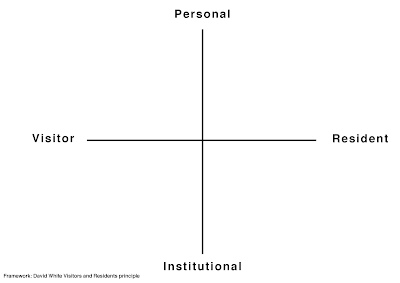A huge shout out to Omer for pointing me to the video series by David White. I admittedly skimmed the week two article on "Visitors and Residents" far too lightly. I resonate so strongly with his view on the Digital Native/Immigrant debate. If you haven't already, please watch the following video.
Just like a language, technology is something that is more easily learned when immersed from a young age. Those that did not grow up immersed in technology can learn to be more tech savvy, but just like learning a second language later in life, it will not be innate in the same way your first language is.
As I have mentioned previously, I do not believe age is the deciding factor in someone's comfort around technology. Socioeconomic, cultural bars, and other factors that may keep the youth disconnected which could result in discomfort later on if leveraging technological tools.
White's model of Visitors and Residents is based upon engagement and willingness to engage online. On his sliding scale, someone operating in a visitor capacity may be using the web as a tool to look up hours for a coffee shop. Those operating on the resident end of the spectrum live a portion of their life online and leave a lasting mark by engaging and contributing to their online community.
Again, the ideas behind White's framework hinging on the intent of the user is something that connects with me on the concept of the Digital Native debate.
He goes on to expand the linear framework into a coordinate system with an x-axis - on top, personal use and professional/institutional on bottom. This graph is expanded on in a second video which addresses credibility of material online and "black market" learning. Basically, White explains, students are residents in the personal dealings online and institutions have set up for students to only utilize the web in a visitor capacity.
The work that we are doing in EME6414 is unlike that of any class I have taken before. It makes sense that we operate online in this way because of our subject matter. There is so much potential for more courses covering an array of topics to function in a way that encourages students to engage with web 2.0 tools online with the intent of being a resident. Along with learning content, students cold also hone skills in netiquette and how to use social media in a way they may be unfamiliar with.
What are your opinions on the Visitors and Residents framework versus Digital Natives and Immigrants? For those that speak multiple languages, what are your opinions on the comparison of technology to language? How could you engage learners within the resident and institutional quadrants within your work? Is there merit in engaging learners in this way?

Your point about socioeconomic and/or cultural factors being a bigger bar to engaging online than age is interesting. I think we are seeing this clearly during the COVID-19 crisis. What other factors do you think might be relevant?
ReplyDeleteYou are absolutely correct that COVID-19 has placed a spotlight on how technological barriers are affecting people across the globe.
DeleteI believe that socioeconomics plays the largest role in disproportionate access to technology. Those that do not have personal computers in their home or those that rely on public access through libraries and school will inevitably clock less hours growing comfortable in online communities. In the age of COVID-19, they may be completely cut off save for a smartphone. A PEW Research Center survey conducted earlier this year shows that 71% of Americans making below $30,000 annually do have a smartphone, but less than 56% have a desktop/laptop, broadband, or tablet (Anderson & Kumar, 2019).
Geographic location also demonstrates disproportionate access to technology. Many rural Americans, for example, lack access to broadband internet. This lack of access changes how people can interact in online communities and the frequency of which they can engage. While the number is decreasing, there were still 21.3 million Americans in 2017 that lacked a connection of at least 25Mbps, the FCC benchmark (Federal Trade Commission, 2019).
As for cultural barriers, I have no empirical data regarding a direct impact on culture to engagement online. My initial thought was two-fold. In the case of developing countries, remote locations and/or poverty would be more prevalent among the populations and that some would not even have consistent access to electricity. I also thought that in countries where the state censors content online, that there may be a different view of adapting to a more residential lifestyle online.
Thank you so much for taking the time to read my thoughts on the subject. I really appreciate it along with the great work you have done in redirecting the digital native conversation. As I previously stated, I really connected to the V&R model. It has challenged me to rethink of ways to engage learners in the institutional/resident quadrant and leverage Web 2.0 tools.
References:
Anderson, M., & Kumar, M. (2019, May 07). Digital divide persists even as lower-income Americans make gains in tech adoption. https://www.pewresearch.org/fact-tank/2019/05/07/digital-divide-persists-even-as-lower-income-americans-make-gains-in-tech-adoption/
Federal Trade Commission (2019, May 29). 2019 Broadband Deployment Report. https://docs.fcc.gov/public/attachments/FCC-19-44A1.pdf